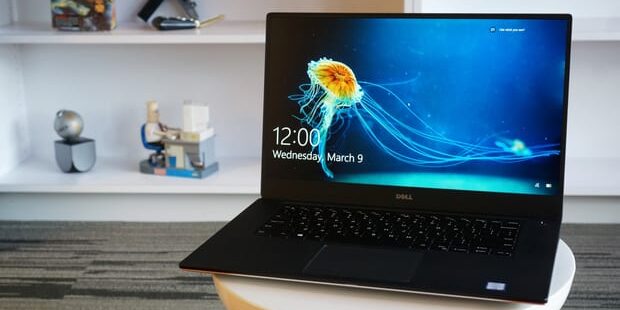It doesn’t take a genius to realize that when you hit pay dirt, you might do so again if you keep digging in the same area. That’s the tack Dell takes with its redesigned XPS 15 laptop: It’s easily summed up as a bigger, more powerful version of the super-popular XPS 13.
Bigger isn’t always better, of course, but in the case of the XPS 15, it worked out pretty well. Its body has the same aluminum top and bottom. The familiar carbon-fiber keyboard deck is there, too. Also like the XPS 13, this XPS15 features an ultra-thin “InfinityEdge” bezel around its 15.6-inch screen.
The model I reviewed is mid-range. That means a 1920×1080 resolution non-touchscreen, though a 4K Ultra HD screen with touch is available. Regardless of screen type, you get that 5.5mm-skinny bezel, and it makes for an impressive presentation—for comparison, HP’s Spectre X360 15T has a 15mm-wide bezel. But oddly, the XPS 15’s bezel didn’t wow me the same way the original XPS 13’s did, even though both bezels are basically the same size. The narrow bezel looks great except from this angle
Like its sibling, that thin bezel results in the same awkward camera placement. Instead of residing at the top of the screen, the XPS 15’s camera sits in the lower lefthand side. That means people who do a lot of typing during video calls had mind their cuticles.
The slender bezel also means Dell had to do some gymnastics to backlight the screen properly. This isn’t something you would notice under normal circumstances, especially because it’s an IPS panel and has good off-axis viewing angles. However, when I placed the XPS 15, HP Spectre X360 15T, and Samsung’s Book 9 Pro in a dark room and cranked up the screen brightness of each, the XPS 15 showed more backlight bleed. I’d rate the Spectre X360 15T first in quality, with the Samsung Book 9 second.
The image quality on the XPS 15 is fine, but it’s worth noting that the anti-reflective screen on our test unit will, basically by definition, look duller than the glossy displays on the HP and Samsung. What you give up in eye-catching pizzazz, though, you get back in greatly reduced glare..
You get Thunderbolt 3 on the new Dell XPS 15 (bottom) and the new Dell XPS 13 (top) but only the Dell will charge from the port.
Ports: a note about the USB-C
For ports, you get an SD card reader, a USB 3.0 Type A port, and a Kensington lock on the left side. On the right, you’ll find a full-sized HDMI and second USB 3.0 Type A port, combination analog audio jack, and a USB 3.1 Gen 2 10Gbps Type C port with Thunderbolt 3 support. Nothing wrong with this selection, but I’d like to put in a good word for those of us with older hard drives that require dual Type A plugs to get enough power. On the XPS 15, such an accessory wouldn’t work without an optional adapter cable.




